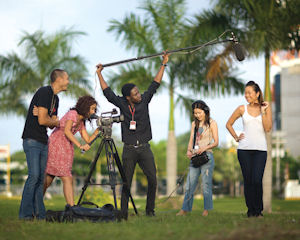The International Academy of Film and Television has come to the film capital of the world with plans to begin summer programs for film students. The academy opened its Burbank campus at the beginning of May with an initial offering of acting classes. This summer the school will begin its degree and certificate programs and workshops in film production. The academy began on the island of Cebu in the Philippines and last year acquired the Miami Film School as its second location. A Hong Kong campus also opened in May. Kacy Andrews, the school’s co-founder, said a Los Angeles area location was always a goal, but it required careful thought and planning. After all, the region is home to some of the most prestigious film programs in the world including USC, UCLA, the American Film Institute, the west coast campus of the New York Film Academy, and California Institute of the Arts. “We did not want to come hastily into the market without feeling comfortable about what we are offering and how we differentiate ourselves from the other schools,” Andrews said. The school aims to set itself apart by playing up the international aspect of its name. The flagship campus on Cebu, which operates out of Bigfoot Studios, hosts students from 33 countries. With a network of schools, students have the opportunity to travel, Andrews said. A student, for instance, can start the program in Burbank and then head off to one of the Asian campuses to do their thesis film, she added. “Another way we stand out is we are a boutique school with small intimate classes,” Andrews said. “We are not out to have students pay the fees other schools charge.” The one-year diploma film program has tuition of $14,990 at the IAFT. By comparison, a one-year program at the Universal Studios campus of the New York Film Academy costs $19,000 per semester, plus a $2,000 per semester equipment fee. (The summer program costs $18,000 per semester.) The school draws from a wide field for its students — from college-aged beginners to working entertainment industry professionals to people making a mid-life career change who have an idea for a film or documentary. Los Angeles resident Steve Angeles, a journalist for a Filipino television network, completed the academy’s four week acting workshop earlier this month. He chose IAFT because of the good things he had heard about the school and its acclaimed reputation in the Philippines. The workshop would benefit a new actor, or someone who has not acted in a long time, because it covered all the aspects of acting, Angeles said. Additionally, it was a small class — just him and another student — which meant a lot of attention from the instructor. “It was like having a personal coach,” Angeles said. The school has five terms per year and takes in between 10 to 15 students for the diploma program in filmmaking. Keeping with the global perspective, the academy is working on making the Burbank campus a destination, Andrews said. “We are reaching out to other countries and bringing students over for limited amounts of time,” Andrews said. In 2010, the Hollywood Reporter included the Philippines campus among the best film programs in the world, citing how students have access to state-of-the-art equipment and facilities and receive a hands-on approach to filmmaking. Andrews and the other executives operating the school bring years of experience in the entertainment industry. Her resume includes low-budget independent feature films, television series, theater and animation. Chief Operating Officer Jim York was the founder of the Miami Film School and has been executive producer on 400 student films. The Burbank campus has a staff of five and Andrews does not foresee hiring additional employees. The teachers and mentors are part-time workers and assist as needed.
